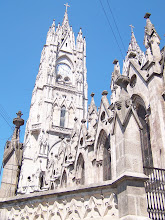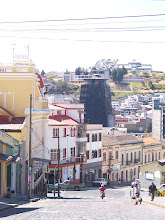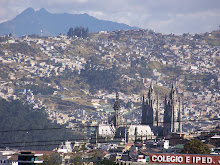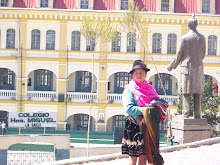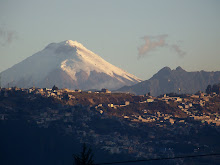January is now coming to a close, and I´ve finally hit a stride with my classes again. It´s impossible to say how much easier teaching a course is the second time around. Even though I´m changing my curriculum quite a lot, my lessons seem to flow with ease from one to another, and I can focus more on my students and their needs rather than on my own nervousness as a new teacher.
I also learned that at ESPOCH, my university, few students tend to sign up in the winter and spring. My first day, four students straggled into my first class, and I sat in an empty classroom for my second class. By now I´m up to a grand total of 9 in the first and 6 in the second, but I really can´t complain about the luxury of small classes. At the very least, it´s easier to correct assignments and remember names, particularly since my students have shown up bearing some of the most unusual names I have ever heard - Belen, Rogel, Aurelio, and Jimena, to name a few. My favorite student name by far, though, is Stalin, who happens to be a shy, gangly high school student who scarcely says a peep. I asked my Spanish teacher if Stalin was a common name around here. "Well, not really," she told me, "but there is someone named Hitler in town."
A change in semesters is one of the few ways a person can keep track of seasons around here. For Christmas, little seemed to change except for Christmas decorations and a plethora or life-size Santa dolls propped up around town. There were also the Pasa del Niños, or Christmas parades, that sometimes involved Christ dolls and other times involved Spiderman, indiginous dancing, and Minnie Mouse. Carmita invited me to participate in such a parade - a little nervous at first about what my costume would entail, it turned out that I would wear white lace pants, a bright red tunic, and a bamboo-frame tapestry...complete with ostrich feather plumes. Let´s say dancing with a three-foot framed tapestry on your head is not for amateurs.
Christmas Day dawned unusually hot, and my friend Stephi and I spent most of it on a bus, practically hanging our heads out the window for air. We were on our way to Tena, a jungle village, to begin a tour the next day. We told ourselves we would find a nice restaurant in Tena to celebrate the holiday, but it turned out there was little to satisfy the gringo palate in Tena. At the end we found a lonely diner on the edge of town, where we nibbled on limp grilled cheese sandwiches as shirtless local boys stared curiously at us through the windows.
We began our tour on the 26th, climbing into an ancient jeep packed with provisions and a set of rubber boots. It took awhile to acclimate to the heat, but once we did, it was worth it. Our first day we donned our giant boots and squelched our way along mud trail, enormous vines sweeping over our heads and trees so tall it was difficult to see the top. Insects and birds chirped in the trees, and occasionally we could hear a monkey chatter. Once we were lucky enough to see a colibri - a hummingbird - flit in front of us for a moment and hang there, suspended, before it vanished in thrum of wingbeats. Perhaps my favorite were the butterflies who floated by; they gleamed in metallic blues and yellows when they caught the sunlight that filtered to the forest floor.
We stayed in the forest for four days, sometimes hiking and sometimes traveling along the muddy Napo River by motorized canoe. Our last day we did a river hike, wearing only our underwear and boots, clambering over rocks and looking for crabs that scuttled along the steep banks. We spent our nights in little cabañas, eating dinner by candelight as their was no electricity, our ears engulfed in the buzz of frogs and insects that seemed to thicken the already-dense jungle air.
As interesting as it was to experience the jungle, though, I was content to trade the sticky humidity of the Oriente for the cool breezes of the mountains. For New Year´s we went to Quito, where the streets were packed with people in costume: clowns and gorillas and cartoon characters were all swinging their Pilsners through the streets of Quito, yelling and generally causing a ruckus. Well, until about 10 o´clock, that is. At ten o´clock all of these creatures all promptly vacated the streets to go celebrate with their families. The streets weren´t entirely empty at twelve, however. Across Ecuador it´s tradition to build life-size dolls out of old clothes and newspaper, which are burned at midnight to represent the passing of the old year. It´s a peculiar sight, to say the least, to see giant fires spring up around the familiar streets of Quito.
And so here I am, almost done with January, and the entire country is gearing up for Carnaval (Mardi Gras). While Mardi Gras in Minnesota passes with maybe a gaudy necklace or two, in Ecuador it calls for two days off work and at least four days of celebration - some towns have already been celebrating for about two weeks, even though Carnaval itself isn´t until mid-February. "Celebrating" mostly consists of assaulting your fellow civilian with kitchen items - water, flour, and eggs to name a few. In the city of Ambato, people are banned from throwing flour, but for some reason it´s ok to throw fruit - I must admit I´d rather get splashed with some flour and water than take a papaya to my head. Already, I´ve been doused with water dumped from a fourth story window while I was walking to meet a friend for coffee. I have no doubt that the best is yet to come.
Saturday, January 30, 2010
Subscribe to:
Comments (Atom)







